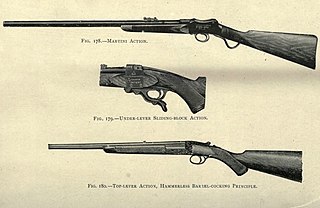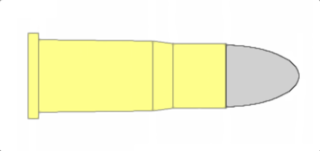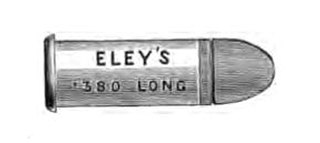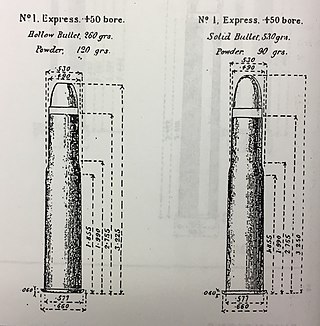
The .303 British or 7.7×56mmR, is a .303-inch (7.7 mm) calibre rimmed tapered rifle cartridge. The .303 inch bore diameter is measured between rifling lands as is the common practice in Europe which follows the traditional black powder convention.

The double rifle, also known as a double-barreled rifle, is a rifle with two barrels mounted parallel to each other that can be fired simultaneously or sequentially in quick succession. Synonymous with big game hunting found primarily in Africa and Asia, the double rifle is a sporting weapon with very little military heritage.
The .577 Nitro Express is a large-bore centerfire rifle cartridge designed for the purpose of hunting large game such as elephant. This cartridge is used almost exclusively in single-shot and double express rifles for hunting in the Tropics or hot climates in general and is a cartridge associated with the golden age of African safaris and Indian shikars.

The .310 Cadet, also known as the .310 Greener, or the .310 Martini, is a centerfire rifle cartridge, introduced in 1900 by W.W. Greener as a target round for the Martini Cadet rifle. Firing a 120 grain heeled lead projectile at 1350 ft/s the round is similar in performance to the .32-20 Winchester and some rifles may chamber both rounds with some accuracy. The full metal jacketed round was used in cadet rifles in Australia and New Zealand after early 20th-century Defence Acts. In New Zealand, after the start of the Boer War, a cadet corps had been started; by 1901 it was recommended that membership be compulsory. 500 Westley-Richards miniature Martini–Henry rifles were available by October 1902, and 5000 by April 1903 (Star). Such rifles gained popularity in Australia, New Zealand and the United States when thousands of Martini Cadet rifles were sold by the Australian government after World War II. A shorter version used as a humane killer was used in pistols. Known as the .310 cattle killer, invented by WW Greener, it was shorter in that a .310 cadet could not be accidentally chambered into the humane killer pistol.

The rook rifle, originally called the rook and rabbit rifle, is an obsolete English single-shot small calibre rifle intended for shooting small game, particularly rook shooting.
The .333 Jeffery and .333 Jeffery Flanged are medium-bore rifle cartridges developed by W.J. Jeffery & Co and introduced in 1908.

The .318 Westley Richards, also known as the .318 Rimless Nitro Express and the .318 Accelerated Express, is a proprietary medium bore centerfire rifle cartridge developed by Westley Richards.
The .350 Rigby and .350 Rigby No 2 are proprietary medium bore rifle cartridges developed by John Rigby & Company.

The .255 Jeffery Rook / 6.5x29mmR, also known as the .255 Jeffery Rook Rifle, is an obsolete small bore intermediate firearm cartridge.
The .400 Purdey, also known as the .400 3-inch Straight and .400 Purdey Light Express 3-inch, is an obsolete rifle cartridge developed by James Purdey & Sons.

The .300 Rook / 7.6x30mmR, also known as the .295 Rook, is an obsolete intermediate centerfire rifle cartridge.

The .297/250 Rook / 6.4x21mmR is an obsolete centerfire rifle cartridge developed by Holland & Holland.

The .360 No. 5 Rook / 9.2x27mmR is an obsolete centerfire rifle cartridge.

The .380 Long [9.8 x 24mmR], also known as the .380 Rook rifle, is an obsolete centerfire rifle cartridge.
The .400/360 Nitro Express cartridges are a number of very similar, but not interchangeable, centerfire rifle cartridges developed by James Purdey & Sons, William Evans, Westley Richards and Fraser of Edinburgh, all at the beginning of the 20th century.
The .360 No. 2 Nitro Express is a centerfire rifle cartridge developed by Eley Brothers and introduced in 1905.

The ball and shot gun, often also known by the marketing name paradox gun, is a shotgun capable of firing both shot and solid projectiles. First built by Holland and Holland, the term paradox is a proprietary name applied to these guns by Holland and Holland.

The .500/450 No. 1 Black Powder Express, known in its day as the .500/450 No. 1 Express, was a centerfire rifle cartridge developed by Westley Richards and introduced in the late 1870s.

The .297/230 Morris Short and .297/230 Morris Long are two obsolete centerfire firearm cartridges developed as sub-caliber training rounds for the British Martini–Henry rifle.
The .375/303 Westley Richards Accelerated Express, also known as the .375/303 Axite, is an obsolete medium bore rifle cartridge.














